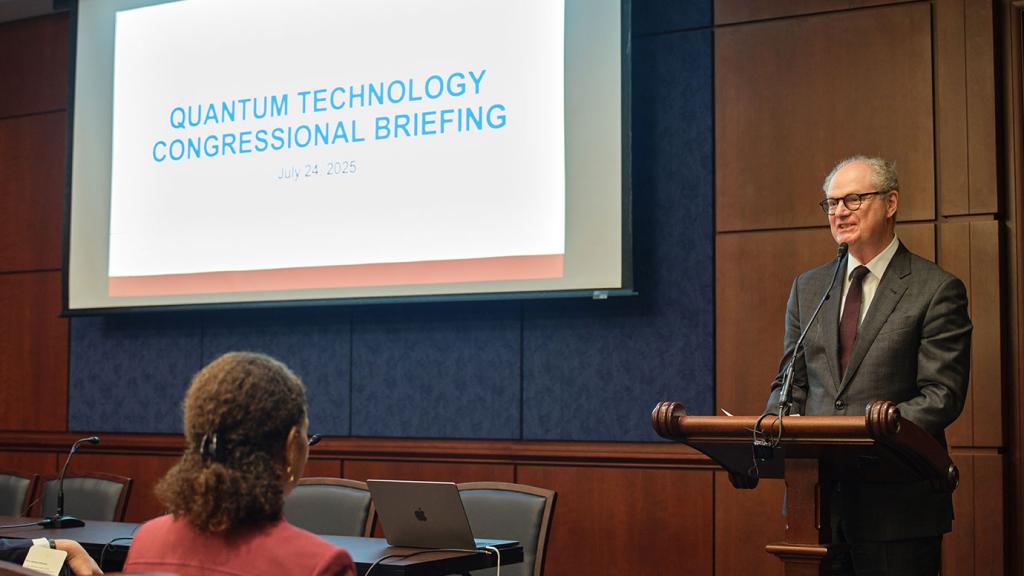A provocative panel of speakers explored the striking similarities – and the discordant differences – between art and science at the first program in the University of Chicago, Argonne National Laboratory, and Fermi National Accelerator Laboratory Joint Speaker Series held last month at the Oriental Institute.
About 100 faculty members, scientists, engineers and researchers came together to launch a series of informal events intended to spark new connections between members of the University and those of the national laboratories.
“We often gather over science, but rarely informally,” said Donald Levy, the Albert A. Michelson Distinguished Service Professor in the James Franck Institute, Chemistry, and the College, and the Vice President for Research and for National Laboratories. Levy, along with Eric Isaacs, Director of Argonne, and Pier Oddone, Director of Fermilab, hosted the event. “This series will further our research goals by narrowing the distance between our three institutions – literally and figuratively,” said Levy.
With a mix of scientists, researchers, artists and art historians comprising a panel, the program, titled “The Art of Science,” kicked off with the panelists addressing some of the distinctions between the practice of making art and doing scientific research.
“Science would never sacrifice content for beauty, which is something artists do all the time,” said panelist Elena Shevchenko.
Assistant Professor and visual artist Jason Salavon noted that, “Scientists want to see what’s there while artists want to express themselves. He added, “Most artists work alone while most scientists work collaboratively.”
Although the discussants highlighted where art and science diverge, they also agreed that both fields provide fertile ground for creativity and curiosity.
“Art and science are both based on the ability to imagine, and if we were limited to things we could see, there would be no joy,” said art historian Barbara Stafford.
The discussion also focused on how art can be vital to understanding science.
“Computer–generated art allows us to look at things that we couldn’t see otherwise, like the universe from outside the universe,” said astrophysicist Nick Gnedin.
Mike Papka from Argonne noted that art aids scientists in moving their research to new levels of exploration. “An experiment that simulates the explosion of a star can create more than one billion data points. Artistic representation is a powerful tool that helps scientists make sense of mountains of data and furthers their experiments.”
“Now there will be closer collaboration between art and science at these three institutions,” said Chairman of Astronomy & Astrophysics Edward “Rocky” Kolb, who moderated the panel. “The take–home message was that science can inform art, and art can be a great way of representing research results to scientists and the public,” said Kolb, the Arthur Holly Compton Distinguished Service Professor and a member of the Enrico Fermi Institute.
Larry Norman, Deputy Provost for the Arts at the University, appreciated the dialogue. “A beautiful moment for me was when someone in the audience said that science and art both slow things down because they both demand intense focus and concentration,” he said. “This slowing down is true not only for the artist and scientist but also for those seeking to appreciate the art or understand the science.”
At the event, Norman pointed out that the University is committed to ensuring that arts activities across campus contribute to the intellectual life of the entire University as well as the Labs, and that the new Reva and David Logan Center for Creative and Performing Arts will be central to this effort.
Elton Kaufmann, Associate Director of the Strategic Planning Group at Argonne, said of the discussion, “This kind of thing is great because it gets the right side of my brain working. Something I’ve been trying to do for years,” he quipped.
The panel members were Nick Gnedin, Theoretical Astrophysicist at Fermilab and Associate Professor of Astronomy and Astrophysics at the University; Mike Papka, Deputy Associate Laboratory Director of Computing, Environment and Life Sciences at Argonne; Jason Salavon, Assistant Professor in Visual Arts at the University and Research Fellow at the Computation Institute; Elena Shevchenko, Nanoscientist at Argonne; and Barbara Stafford, the William B. Ogden Distinguished Service Professor Emerita in Art History.






